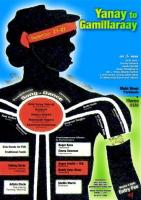(UPDATE in the Sydney Morning Herald. COULD it have been the ground-breaking corroboree
that stirred up this week's dust?)
If you’re interested in Australian Aboriginal culture and happen to be in Australia in September you might like to catch one of the biggest indigenous dance festivals and corroborees ever seen.
Yanay Gamillaraay, which roughly translated means come and go, learn and share the culture of the Gamillaraay (Gumilaroi) people, will take place from September 21 to 27 in the Outback town of Moree, which lies 627 kilometres northwest of Sydney.
A corroboree is a ceremonial meeting. The word was coined by European settlers in imitation of the Aboriginal word caribberie. At a corroboree Aborigines interact with the Dreaming (Creation) through dance, music and costume. Many ceremonies act out Dreaming events. Many ceremonies are sacred and banned to outsiders.
Organisers say it’s the first corroboree in the area since 1938. They expect thousands of people from all over Australia to attend.
From an invitation the organisers sent out in June: “The Biliir Dancers of the Gamilaraay traditional yulu-gi (song and dance) invite all Aboriginal clans, tribes and nations to send your traditional performers to join us in creating the first ever Dance Corroboree to be hosted in NSW in modern times.
“For tens of thousands of years, we Gamilaraay people sang and danced our lore across our homelands. Stopped by authorities in 1938, we seek your support for the revival of our Corroboree of Culture based on traditional practices and materials – the first Yanay to Gamilaraay! Festival (Y2G!).
“The Y2G! festival will be held in the Traditional Homelands of the vast Gamilaraay Nation of Northern NSW and Southern Queensland.
“Within the Gamilaraay Nation traditional cultural teachings and practices are still being taught and passed down to the next generations of Gamilaraay. The Indigenous and non-indigenous communities of Moree, surrounding family clans and language groups of Gamilaraay see the Y2G! festival as a stepping stone to building positive relationships in the spirit of Reconciliation.
“A key component of the Y2G! Festival will be to ensure that all participants and performers learn certain aspects of traditional teachings, knowledge and culture of Gamilaraay.
“The festival will consist of traditional dancers, storytellers, contemporary performers, poets and artist from around the Gamilaraay Nation and around Australia showcasing their professionalism by continuing in the age old Traditions of exchanging cultural knowledge and practices by conducting workshops within their specialized fields throughout the festival.”
Director Paul T Spearim can be reached by phone on #61 403-883-359, email paulspearim@yahoo.com, his sister on 411-824-176 and bspearim@yahoo.com.au.
Read more in the local paper, the Moree Champion, and at the corroboree website.
Moree has a population of about 8,000 in the town itself, 14,000 in the shire. 17% are Aborigines, compared with the national 2.6%.
Moree is best known for its famous Artesian spa baths, which each year attract more than 300,000 visitors, mostly overseas tourists. An artesian (underground) well was sunk in 1895 in an effort to find a reliable source of drinking water for Moree.
Since then the well has produced a natural steady flow of warm (41 deg C) water utilised in pools and spas around the town. The water is rich in minerals including sodium carbonate and sodium chloride and is reputed to help rheumatism, arthritic conditions and muscular aches and strains.
Some approximate driving times to Moree are: 9 hours from Sydney (600Km), 16 hrs from Melbourne (1,300 km), 7 hrs from Brisbane (500 km). Trains from Sydney, buses from Melbourne, Brisbane and Grafton and flights from various cities regularly service Moree.
The architecture of the city is reminiscent of colonial Australia which is an added interest for tourists.
In Moree you also appreciate the vastness of Australia, with opportunities to experience Outback places and people. Fishing on the Barwon River at Mungindi and Boomi (95 kms north) is excellent.
And the area is also an introduction to one of Australia’s worst ecological sins, irrigated cotton growing, one of the severest contributing factors to wrecking Australia’s main river system, the Darling-Murray. Australia is the world’s eighth-largest cotton producer.
The world cotton supply remains excessive at a new all-time record. The subsidies given by the US to its cotton farmers have largely been accepted to be the reason for the spectacular global decline in cotton prices.
Those American subsidies are hurting some 10 million farmers in sub-Saharan Africa alone. Four West African countries — Burkina Faso, Mali, Benin, and Chad — are demanding that U.S., China, and European Union cotton subsidies be included in all international trade talks on agriculture.
Cotton remains the most important source of income for many farmers, especially in the poorer countries, and a major export product for the state. For example, the farmers in West Africa grow cotton very economically, without use of pesticides – and get little thanks for their labours. Their crop accounts for only about 4% of global production.
Without subsidies, it would not pay for Americans to produce much cotton; with them, the US is the world’s second largest cotton exporter (after China). Some 25,000 rich American cotton farmers divide $3 to $4 billion in subsidies among themselves – with most of the money going to a small fraction of the recipients.
Representatives from Benin, Burkina Faso, Chad and Mali, four major cotton-producing African countries, were in Washington in July to address what they consider to be unfair U.S. trade practices.
Australia’s cotton growers receive no direct government subsidies and feel unfairly disadvantaged against overseas growers in subsidising countries.

